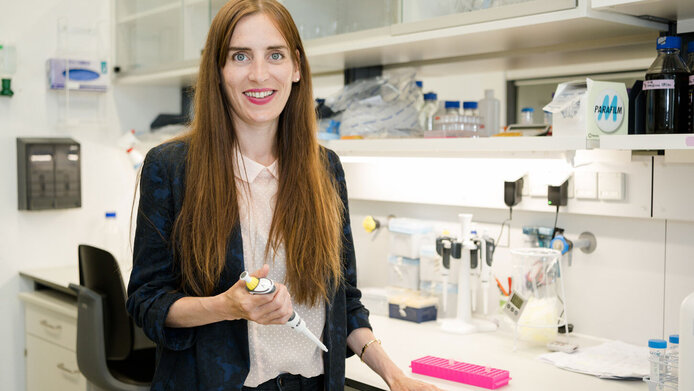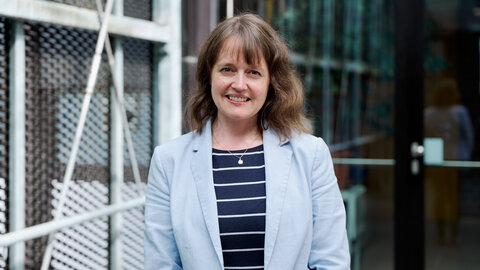How skin cells monitor their neighbors

In your research, you study the development of tissue structures. Why are you specifically interested in skin?
Stephanie J. Ellis: If you look at our skin, you might think that all skin cells are identical. But actually, the skin is more like a mosaic. It consists of small clusters of cells spread over the body like the patches of a patchwork quilt. The individual cell groups are genetically diverse and can, for example, carry mutations that lead to cancer. In addition, skin tissue continues to divide throughout a person’s life and has to allow for adjustments, such as when abdominal girth increases and decreases during pregnancy. For circumstances like these, skin cells have mechanisms that ensure the proper development and health of the tissue. I want to really understand these processes.
What knowledge gap do you want to close with your START project?
Ellis: We know that skin cells are in constant competition: some survive, and others don’t. At first, it was thought to be something like Darwin's “survival of the fittest,” on a smaller scale. Now we have reason to believe that this is an active mechanism. Our hypothesis is that skin cells can sense the fitness of their neighbors and influence selection accordingly. Initial studies by my research group have shown that this mechanism only comes into play when two cells are directly adjacent to each other.
Personal details
Stephanie J. Ellis completed her PhD in cell and developmental biology at the University of British Columbia in Canada in 2014. She was a postdoctoral fellow at Rockefeller University in New York City until 2021 and has been awarded a Human Frontier Science Program (HFSP) Grant, a New York Stem Cell Foundation (NYSCF) Fellowship, and the NIH Pathway to Independence Award. Since 2022, Ellis has been a junior group leader at the Max Perutz Labs in Vienna and teaches as an assistant professor at the University of Vienna.
Based on these findings, I would like to focus on three main questions in my START project: Which aspects are crucial for the fitness of a cell? How can cells determine the health status of their neighbors? And how are “unfit” cells eliminated without destroying the structure of the tissue?
What initial steps do you plan to take to answer these questions?
Ellis: The first goal is to find the molecular regulators of fitness. For this, we will be using spatial transcriptomics, a new technology in our field. It allows us to measure all the gene activity in individual cells without destroying the tissue, giving us a picture of the cells in a neighborhood. For example, we can study what is happening in an unfit cell, and how this activity is different from its fitter neighbors. Spatial transcriptomics is groundbreaking in our field, but it is still so new that very little research has been done on its application until now. This means that part of the project will involve setting up the method we will be using to investigate our research question. At the same time, we will be working with fluorescent markers and microscopy to find out whether a cell’s biomechanical properties influence its fitness. For example, whether cells are more likely to be discarded if they adhere less well to their substrate.
What will the START Award mean for your research activities?
Ellis: The START Award will play a huge role in my research. The experiments we want to conduct are very expensive and would definitely not be feasible without this funding. The research I am planning involves a lot of risk, but also a high payout. The START Award gives me the freedom to take this risk.
What motivates you in your day-to-day research?
Ellis: Like all researchers, I’m driven by the prospect of new breakthroughs. But the greatest motivation is to share these discoveries with others. It’s extremely rewarding to be able to work with so many people who are also fascinated by biology. Conducting research together, sharing ideas, and solving puzzles is especially motivating for me. I have enjoyed it even more since I was given the opportunity to build and lead my own team, where I can share my enthusiasm about how our bodies’ tissues are created with other researchers.
What role models have inspired you?
Ellis: There were many passionate and inspiring people who initially got me excited about the field and who continue to support me in my research. But as a woman, finding a real role model in our field is not easy. While there are more women working in research today than in the past, the truth is that there are still not enough of us. We need to raise more awareness for this situation and demonstrate that things can change.
About the project
The project “Understanding Cellular Community Dynamics in Mosaic Tissues” aims to clarify why some cells of a cell colony perish while others survive. Selection at the cellular level is essential for tissue development and maintenance. Using skin as a model organ, Ellis wants to investigate what differentiates evolutionarily “fit” cells from their less fit neighbors. She will be applying groundbreaking new technologies in her research.
The FWF START Award
The START program of the Austrian Science Fund (FWF) is aimed at outstanding young researchers, giving them the opportunity to plan their research in the long term and with a high degree of financial security It is endowed with up to €1.2 million and is one of Austria’s most prestigious and most highly endowed awards alongside the FWF Wittgenstein Award.





